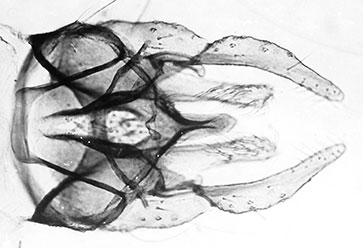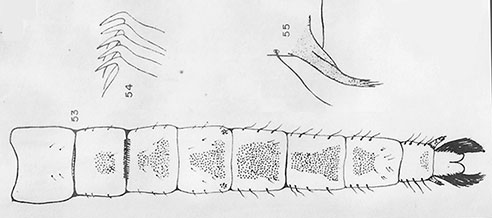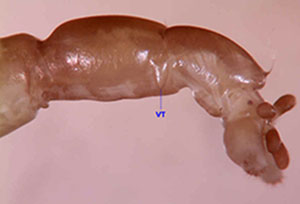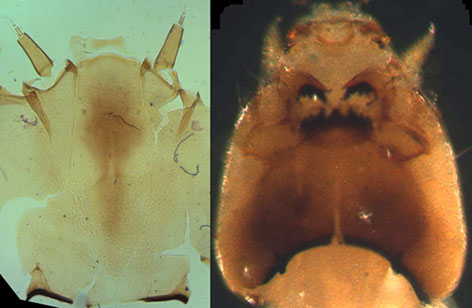Species o. C. cucini Webb, 1969 In BOLD Bin: BOLD:ACQ0844 Adult:
Webb notes that the adult is most closely related to C. staegeri. Male:
Color mostly brown, thoracic vittae and postnotum blackish brown, abdomen dark brown with apical quarter of segments I-VIII pale yellow.
Head: AR 3.7; frontal tubercles long (60 µm); relative lengths palpal segments 2-4: 6 : 20 : 19 : 21. Clypeus 1.3 times antennal pedicel diameter.
Thoracic setae - Acrostichals absent; dorsolaterals extending the length of the vittae; 7-9 prealar; scutellar with numerous setae arranged in 5 transverse rows.
Wing length 4.1-5.2 mm; squama fringed.
Legs dark, tarsal beard very short; proportions:
| Fe
| Ti
| Ta1
| Ta2
| Ta3
| Ta4
| Ta5
| LR
| F/T
| Ta5/Ti
| PI
| 32
| 31
| 42
| 24
| 17
| 13
| 6
| 1.35
| 1.03
| 0.19
| PII
| 36
| 33
| 23
| 14
| 10
| 7
| 5
| 0.89
| 1.09
|
| PIII
| 42
| 42
| 31
| 19
| 14
| 9
| 5
| 0.73
| 1.00
|
| Setae of tergite IX not specified, but there are photographs showing that there are about 9-14 setae in individual spots within a larger pale area. 
Male hypopygium of specimen from Castle Lake, CaliforniaAnal point broad with rounded end; Superior volsella as C. staegeri - i.e. closest to E(i) type of Strenzke (1959); Inferior volsella broad, extending beyond anal point to about halfway along the gonostyle, which narrows relatively markedly over distal third. Female:
Coloration largely as male, but with just the posterior margin of each tergite yellow.
Head: Head, mouthparts and palps fuscous brown. Frontal tubercles large (60 µm); clypeal width twice the antennal pedicel diameter; palp proportions (segs. 2-5): 6 : 21 : 23 : 33; P5/P4 1.43; P5/P3 1.57.
Wing length 5.4-6.3 mm.
Leg proportions:
| Fe
| Ti
| Ta1
| Ta2
| Ta3
| Ta4
| Ta5
| LR
| F/T
| Ta4/Ti
| PI
| 34
| 32
| 42
| 22
| 16
| 11
| 6
| 1.31
| 1.06
| 0.34
| PII
| 38
| 34
| 22
| 13
| 9
| 6
| 4
| 0.64
| 1.12
|
| PIII
| 44
| 43
| 31
| 19
| 13
| 8
| 5
| 0.72
| 1.02
|
| Pupa: (Based on Webb 1969) Length 10.2-11.8 mm. Cephalic tubercles slightly longer than wide, len. about 50 µm, apical setae as long as tubercle. Tergite I lacking spines or spinules. Shagreen pattern as below.
Posterolateral spur of segment VIII with about 4 (2-7) appressed spines. Anal fin with over 50 taeniae. 
53. Shagreen pattern of C. cucini pupa (Webb 1969)Fourth instar larva a large (length 12.1-21.3 mm) salinarius or halophilus-type, i.e. posterior ventral tubules sometimes present (len. abt. 35 mm). Anal tubules about 440 µm long and just over twice as long as wide, dorsal and ventral pair about the same size.

Posterior larval segments of C. cucini
(Photo courtesy of Malcolm G. Butler)
In this larva there is some development of the posterior ventral tubules (VT).Gular region darkened on posterior 1/2 to 2/3, wider than the mentum but somewhat variable: anterior margin vague and may be approximately liner or may be higher at edges; normally wider at base but sometimes a little higher; frontoclypeus pale or slightly darkened with small dark stripe in posterior part and a lobed dark spot in anterior part. 
(Photo courtesy of Isabelle Proulx)Salivary reservoir about 61-83 &181;m long and 2.75-4.1 times wider than deep.
Mentum with relatively shallow curve, teeth pointed; c1 tooth moderately broad, c2 teeth moderately separated; first laterals slope away from centre; fourth laterals definitely reduced (type III).
Anterior margin of ventromentum smooth; 251.5 (243-259) µm wide and about 3.2-3.3 times wider than deep; 1.08 (0.92-1.23) times the mentum width; IPD about 0.37-0.45 of the mentum width; 33-43 striae; VMR 0.25-0.30.
Pecten epipharyngis with 16.2 (11-21) pointed irregular teeth (type D variant)2.0-. Premandible with broad inner tooth about 4.5-5 times the width of the outer tooth which narrows markedly along its length (Type B2).
Antenna with segment 1 relatively long: 2.94 (2.6-3.2) times longer than wide and markedly wider at the base; RO about 0.45 (0.35-0.58) up from base; AR about 2.28 (2.16-2.37); A2/A1 about 0.23-0.25; ratio of segments (µm) 153 : 37.5 : 8 : 15 : 7 : i.e. A5 about 0.88 of A3.
Distance between antennal bases greater than that between the S4 setae, which are separaed by about 0.79 of the FC width at that point. S5 setae mostly anterior to the nearby RO.
Mandible with third inner tooth pale, but separated to varying degrees (type II-IIIA-B); 16-21 furrows on outer surface at the base; 12-15 taeniae in Pecten mandibularis.
Larval characters can be quite variable between locations and even in individual larvae – notably the placement of the RO in A1, which may be 0.40 in one antenna and 0.58 in the other. Cytology: 4 polytene chromosomes with the thummi arm combination AB, CD, EF, G.
Centromeres very heterochromatic, forming a chromocenter with all chromosomes attached.
Arm G with nucleolus, bounded by dark bands, near centromere, then a constriction followed by two Balbiani rings (BRs) which may be more obvious in Californian populations.
No nucleolus in long chromosomes, but a BR may be developed distal to the middle of arm B, particularly in some Californian specimens.
No inversion polymorphism has been observed.
cucA1: 1 - 2c, 10 - 12, 3 - 2d, 9 - 4, 13 -19; i.e. as holomelas, tardus, etc.
cucB1: Commonly a BR towards distal part of arm. Differs from majB1 by a long central inversion.
cucC1: 1-6b, 15c-e, 8-11c, 15b-11d, 6gh, 17a-16, 7d-a, 6f-c, 17b-22 i.e. as islandicus, sp. 3b.
cucD1: 1 - 3, 11 - 18d, 7 - 4, 10 - 8, 18e - 24 ie. as longistylus, tardus (without nucleolus), pilicornis, etc.
cucE1: 1 - 3e, 5 - 10b, 4 - 3f, 10 - 13; i.e as cingulatus, tardus & sp. 3b.
cucF1: 1 - 10, 17 - 11, 18 - 23; i.e. as in tenuistylus, major & tardus.
cucG1: Virtually terminal nucleolus and two central BRs. Found: British Columbia - Osoyoos (Townes (1945) as C. atritibia)
Ontario - Clearwater Lake (46.37°N, -80.05°W) (Proulx et al. 2013): Clarke Lake (45.53°N, -78.27°W), Kearney Lake
(45.57°N, -78.43°W), and Costello Lake (45.599°N, -78.331°W) (Type locality), all Algonquin Provincial Park; Lake Nipissing(?)
Quebec - Lake Bousquet (48.22°N, -78.65°W), Lake Opasatica (48.17°N, -79.33°W), Lake St. Joseph (46.88°N, -71.63°W),
Lake Vaudray (48.07°N, -78.68°W) (Proulx et al. 2013);
California - Lake Davis (abt, 39.42°N, -120.50°W), Plumas Co.; Castle Lake (41.22°N, -122.38°W), Trinity Mts., Siskayou Co.
Indiana - Crooked Lake (41.68°N, -85.03°W) Steuben Co,
Minnesota - Long Lake (44.98°N, -93.57°W), Hennepin Co.
New York - Kanisko Reservoir, Westchester County (Townes (1945) as C. atritibia) Thick mud in depth 5m or more in lakes. Morphology described by Webb (1969) who notes that the adult is most closely related to C. staegeri, but also needs to be compared with C. atritibia. Can be differentiated from C. staegeri most easily by the chromosome number (4 polytenes cf. three) and also in the larvae by the larval type (salinarius or halophilus c.f. plumosus-type in C. staegeri; in the adult by the larger size (wing length 5-6.3 mm cf. 4.1-5.2 mm); and the smaller pale apical band of the abdominal segments; in the pupa by the shagreen patterns and the generally smaller number of spines on the spur.
Karyotype figured by Martin (1979) and described by Wülker & Butler (1983).
This may be Chironomus species B of Hilsenhoff and Narf (1968).Karyotype figured by Martin (1979) and described by Wülker & Butler (1983). This may be Chironomus species B of Hilsenhoff and Narf (1968). Molecular data:
Sequence of the Barcode region of MtCOI was included in Proulx et al. (2013) and has GenBank accession numbers KF278284-290 and the gb2Β sequence has KF278417-420. See also C. staegeri, and C. atritibia[ Return to Index| Go to References ] |



